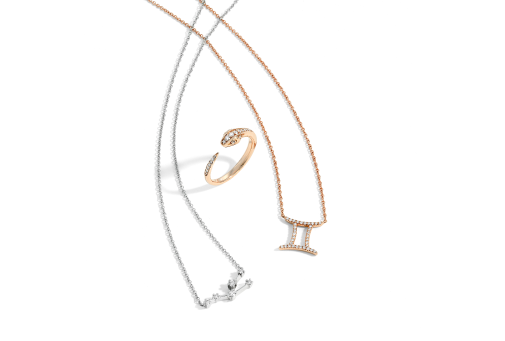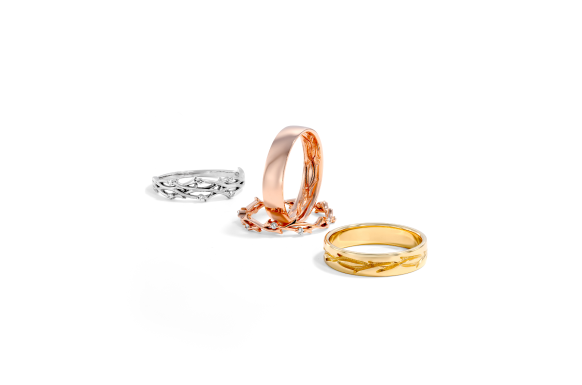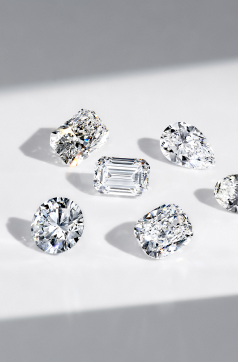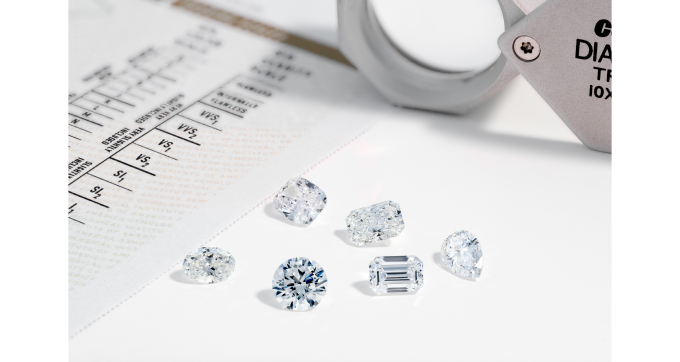14k vs 18k white gold
When we talk about gold, the karat number refers to purity. 24k gold is 99.9% pure. You would think this is good - but pure gold is so soft it dents and scratches easily. It’s not used in jewelry.
Instead, jewelers use 14k and 18k gold: the two types you can buy at Keyzar. The difference between the two can’t be seen with the naked eye. Why?
Because all white gold is rhodium-plated. The rhodium is there to increase white gold’s lifespan and prevent it from scratching or tarnishing. This means what you really see when you look at a ring is rhodium, not the white gold itself.
Underneath the rhodium, 14k white gold is a little whiter and more durable. 18k white gold has more of that rich, warm golden hue - but is a little softer. As we already said, though, there’s no visual difference once we plate either alloy.
A diamond with outstanding clarity has few (or no) inclusions and blemishes. However, this doesn’t mean you have to shop for flawless stones and nothing else. It’s possible to get a large, sparkly, eye-clean rock in lower clarity grades.
What does clarity affect?
Clarity can impact the price of a diamond which tends to be a top consideration for most diamond buyers. Only the most rare and expensive diamonds have no inclusions. Unless you recently won the lottery, you may want to find out more about clarity and pricing!
A more affordable way to get diamonds with no inclusions is to go lab-grown. Lab-grown diamonds still have inclusions, but with high clarity grades your options are more affordable.
What is a diamond’s clarity, exactly?
Inclusions are imperfections within the diamond. Blemishes affect the surface of the gem. Both happen when tiny bits of air, metal, and other particles get stuck inside a diamond as it grows.
Diamonds with large inclusions and blemishes have poor clarity. Diamonds with small (or no) inclusions or blemishes have good clarity. The position, size and visibility of inclusions can have a huge impact on its clarity and price.
Diamond Clarity Grades
To determine the clarity, the GIA (Gemological Institute of America) uses a diamond clarity scale, consisting of 11 grades: You can find out a diamond’s grade on its certificate. We display the color grade for each of our stones in our diamond catalogue. The shorthand for different grades such as VVS1 or SI2 are used internationally by jewelers so it's worth understanding their meaning when shopping for a diamond.
However, no two diamonds are the same. You should check a diamond out before buying, using a tool like Keyzar’s 3D preview, to see any possible inclusions. If inclusions are located in the table of a diamond, they will generally be easier to see. Even a small one could ruin your ring’s look.
Keep in mind that inclusions and blemishes may not be visible to naked eye but only by a trained diamond grader. What matters is that a stone is eye-clean.
| Clarity grade | Meaning |
|---|---|
| Flawless (FL) | No inclusions or blemishes using 10x magnification |
| Internally flawless (IF) | No inclusions using 10x magnification |
| Very very slightly included (VVS1 and VVS2) | Slight inclusions barely visible to a skilled diamond grader using 10x magnification |
| Very slightly included (VS1 and VS2) | Small inclusions ranging from difficult to somewhat easy to identify by a grader using 10x magnification |
| Slightly included (SI1 and SI2) | Inclusions are visible with 10x magnification |
| Included (I1 I2 and I3) | Obvious inclusions using 10x magnification which might affect brilliance and transparency |
Eye-clean: the only diamond clarity grade that (really) matters
‘Eye-clean’ is when there are imperfections visible to the naked eye. This is the only thing you want (unless you’re a professional diamond trader). Spend your money on size, not on clarity; just go for eye-clean.
SI1 diamonds are usually eye-clean but to make absolutely sure you can use our 3D preview tool to see for yourself. If you go for a brilliant cut diamond, a below-SI1 clarity may not be an issue as the sparkle will obscure the inclusions and blemishes.
Low sparkle cuts like the Asscher generally need to have a higher clarity to avoid visible imperfections. Here we don’t recommend anything less than VS1.
If you want to splurge, we suggest doing so on cut; not clarity.
Cut First, Clarity Later
If your cut is poor, it doesn’t matter how clean the diamond is. It’ll look lifeless and crummy. Our advice is to aim for eye-clean diamonds in lower clarity grades. If ordering from us, get in touch with Keyzar. We might help you save even more money by using prongs and bezels to hide light defects.
Eye-clean: the only diamond clarity grade that (really) matters
‘Eye-clean’ is when there are imperfections visible to the naked eye. This is the only thing you want (unless you’re a professional diamond trader). Spend your money on size, not on clarity; just go for eye-clean.
SI1 diamonds are usually eye-clean but to make absolutely sure you can use our 3D preview tool to see for yourself. If you go for a brilliant cut diamond, a below-SI1 clarity may not be an issue as the sparkle will obscure the inclusions and blemishes.
Low sparkle cuts like the Asscher generally need to have a higher clarity to avoid visible imperfections. Here we don’t recommend anything less than VS1.
If you want to splurge, we suggest doing so on cut; not clarity.
Cut First, Clarity Later
If your cut is poor, it doesn’t matter how clean the diamond is. It’ll look lifeless and crummy. Our advice is to aim for eye-clean diamonds in lower clarity grades. If ordering from us, get in touch with Keyzar. We might help you save even more money by using prongs and bezels to hide light defects.
Conclusion
So the good news is you don’t need to spend a fortune for a high quality diamond with superb clarity and sparkle. You just need to consider the 4C’s; Cut, Clarity, Color and Carat Weighting. Plus, make sure you find out the clarity grading of the diamond for an expert opinion. Hopefully, with our help you now have a better idea of what to look for.



